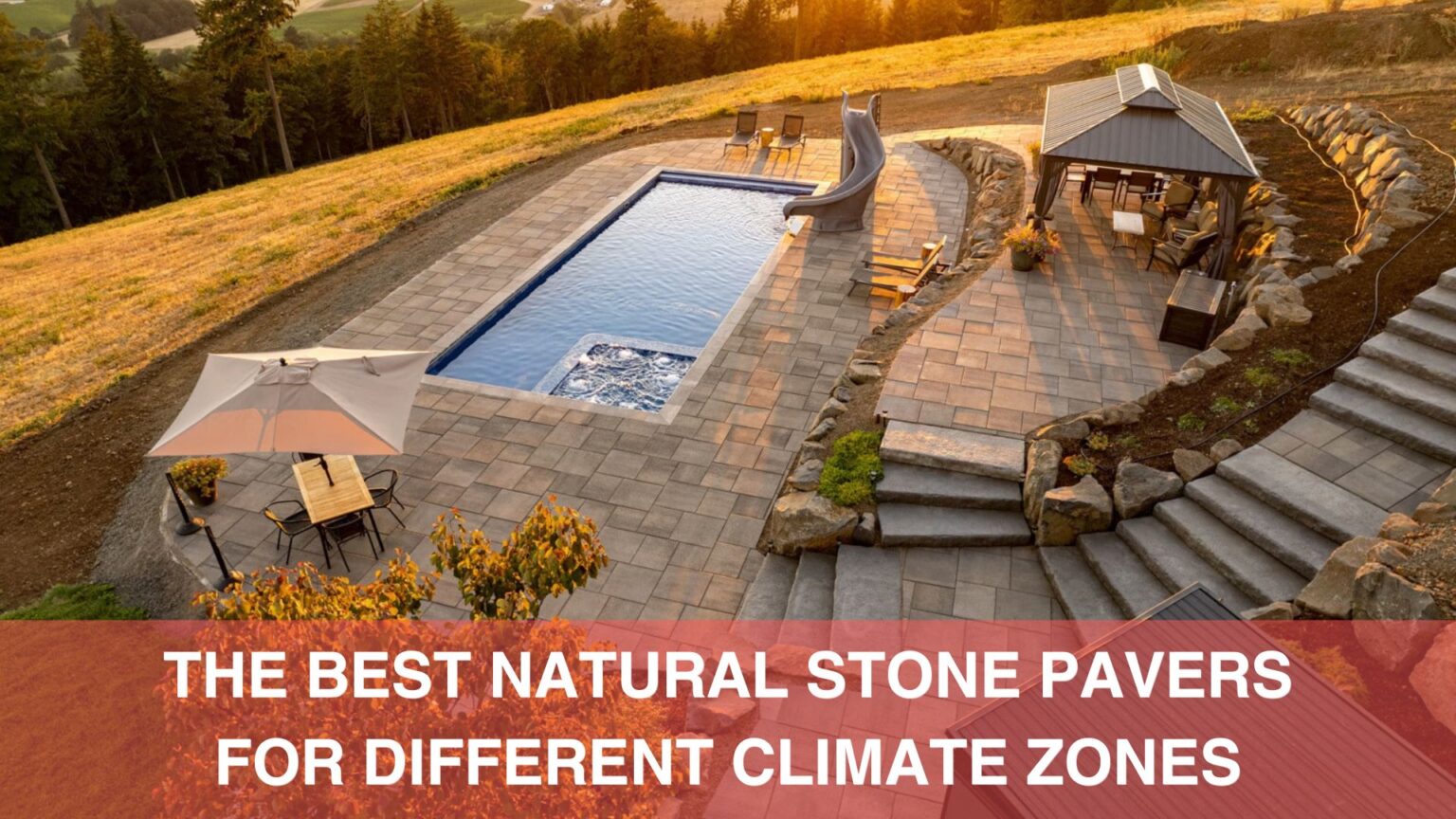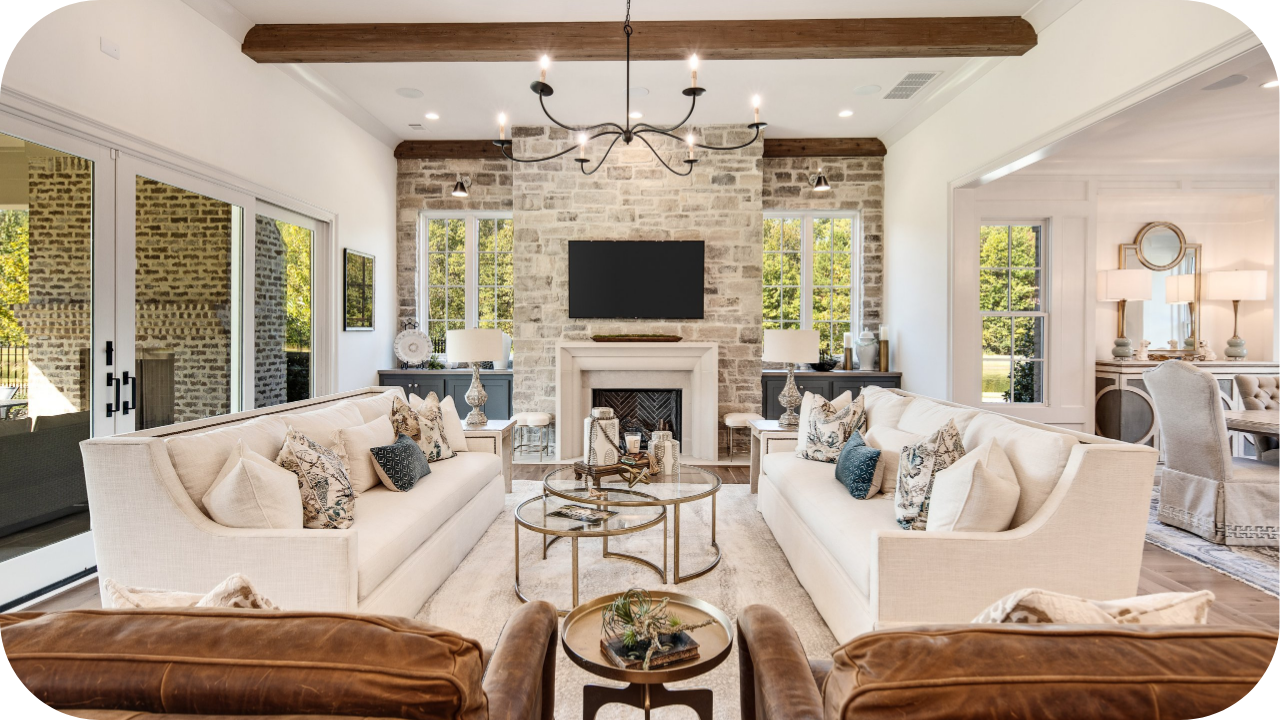
Choosing the right natural stone pavers for outdoor spaces is crucial, but finding materials suited to your climate can be challenging.
Harsh weather conditions like extreme heat, freezing temperatures, or excessive moisture can cause cracking, fading, and other damage to poorly selected pavers.
Fortunately, this guide explores the best natural stone options for hot, cold, wet, and dry climates, ensuring your paved areas remain beautiful and durable for years.
1. Tropical Climates
Tropical climates are known for their high humidity, heavy rainfall, and consistently warm temperatures, making the selection of outdoor paving materials crucial. Natural stone pavers like granite and bluestone are particularly well-suited for these conditions due to their durability and weather resistance.
With its low porosity and robust nature, Granite is highly resistant to water absorption, making it an excellent choice for areas with heavy rainfall. Its non-slip surface adds an extra layer of safety in wet conditions.
Similarly, with its dense composition and fine-grained texture, bluestone offers exceptional resistance to weathering and moisture. Its attractive blue-grey colour also enhances the aesthetic appeal of tropical landscapes.
The benefits of using granite and bluestone in tropical climates are numerous. Both stones are incredibly durable and can withstand the high moisture levels and temperature fluctuations typical of these regions, ensuring they last for years.
Additionally, they are low maintenance, requiring only regular sweeping and occasional pressure washing to remain pristine. Their non-porous nature also makes them resistant to mould and mildew, common problems in humid environments, further solidifying their status as ideal choices for outdoor paving in tropical climates.
2. Temperate Climates
Temperate climates, characterized by moderate temperatures and distinct seasonal changes, including warm summers and cool winters, necessitate using versatile and durable materials for outdoor paving.
Limestone and sandstone are excellent choices for natural stone pavers in such climates due to their ability to withstand these conditions effectively. Limestone is particularly favoured for its aesthetic appeal and the wide variety of colours it offers.
Its dense yet workable nature makes it ideal for creating elegant and durable surfaces that can endure the seasonal changes typical of temperate regions. Similarly, sandstone is renowned for its natural beauty and slip-resistant surface, making it a practical option for areas that experience weather conditions without significant wear.
The benefits of using limestone and sandstone in temperate climates are evident in their durability and versatility. Both materials are robust enough to handle these regions’ temperature fluctuations and seasonal changes, ensuring long-lasting performance.
Additionally, their availability in various textures and colours allows for creative and personalized outdoor spaces that cater to different aesthetic preferences.
Regular cleaning with a mild detergent and water is recommended to maintain the appearance and longevity of these stones. In temperate climates, sealing the stone prevents moisture infiltration and frost damage during winter, ensuring that these pavers remain in optimal condition throughout the year.
3. Arid Climates
Arid climates, characterized by high temperatures and low humidity, present unique challenges for outdoor paving materials. It is essential to choose stones that can endure intense heat and minimal moisture.
Travertine and porphyry are excellent choices for natural stone pavers in arid climates due to their ability to meet these demands effectively. Travertine, a type of limestone, is particularly valued for its durability and heat resistance.
Its light colour reflects sunlight, helping to keep surfaces cooler, making it ideal for hot, arid environments. Porphyry, a dense igneous rock, offers excellent thermal stability. Its distinctive appearance and various colours make it a visually appealing and practical choice for withstanding the harsh conditions of arid climates.
The benefits of using travertine and porphyry in arid climates are significant, particularly in heat resistance and maintenance. Both stones can withstand high temperatures without degrading, ensuring longevity in such environments. Moreover, these materials require minimal maintenance due to the need for more moisture in arid regions.
Regular sweeping and occasional washing with water are usually sufficient to keep them clean and in good condition.
Additionally, the natural composition of travertine and porphyry provides excellent UV resistance, preventing fading and discolouration from prolonged sun exposure. These qualities make travertine and porphyry ideal for durable and attractive outdoor paving in arid climates.
4. Cold Climates
Cold climates, characterized by freezing temperatures, snow, and ice, require robust and weather-resistant materials for outdoor paving. Bluestone and granite are excellent choices for natural stone pavers in such climates due to their exceptional durability and resistance to harsh conditions.
Bluestone, known for its density and durability, naturally withstands the freezing and thawing cycles without cracking, making it a reliable option for cold regions. Its rough texture also provides good traction, reducing the risk of slipping on icy surfaces.
Similarly, granite, one of the hardest natural stones, offers high resistance to the wear and tear caused by snow, ice, and freezing temperatures. Its low porosity prevents water absorption, significantly reducing the likelihood of freeze-thaw damage.
The benefits of using bluestone and granite in cold climates are substantial, particularly in durability and safety. Both stones can endure repeated freeze-thaw cycles that can cause lesser materials to crack or degrade.
Their natural textures offer excellent slip resistance, enhancing safety during icy conditions. Removing snow and ice is essential to maintaining these surfaces in cold climates. A plastic shovel is recommended to avoid scratching the stones’ surface and to apply a safe de-icing agent for natural stones.
This minimal maintenance ensures that bluestone and granite pavers remain in top condition, providing functionality and aesthetic appeal even in the most challenging cold climates.
5. Coastal Climates
Coastal climates, known for their salt air, high humidity, and frequent exposure to ocean spray, demand outdoor paving materials that are durable and resistant to salt. Quartzite is an excellent choice for natural stone pavers in such environments due to its hardness and density.
This natural stone is highly resistant to the abrasive effects of salt and moisture, making it ideal for coastal areas. Moreover, its natural resistance to chemical weathering ensures that it remains durable and intact, even under the harsh conditions typical of coastal climates.
The benefits of using quartzite in coastal climates are significant, particularly in salt resistance and durability. Quartzite’s non-porous nature prevents salt absorption, reducing the risk of damage caused by prolonged exposure to salt air and ocean spray.
This characteristic makes it an ideal material for paving in coastal areas. Additionally, quartzite’s ability to withstand high humidity and varying temperatures ensures its longevity, as its hardness protects it from constant exposure to harsh environmental conditions.
Maintenance is straightforward, involving regular rinsing with fresh water to remove salt deposits and prevent buildup. Periodic cleaning with a mild detergent and water will help maintain its appearance, keeping quartzite pavers pristine and functional in coastal settings.
6. Considerations for All Climates
When choosing natural stone pavers, it’s crucial to consider factors that affect their performance across various climates.
Natural stone is highly durable and versatile, making it an excellent option for outdoor spaces in extreme and mild weather conditions. However, each climate presents unique challenges that must be addressed to ensure longevity and maintain the aesthetic appeal of your pavers.
Opt for stones resistant to fading and heat absorption in hot, dry climates, like granite or light-coloured limestone. These materials reflect sunlight, reducing surface heat and providing a more comfortable walking area.
Conversely, freeze-thaw cycles can cause cracking in cold climates, so choose frost-resistant stones like sandstone, which can withstand temperature fluctuations without significant damage.
For areas with heavy rainfall or high humidity, ensure that the stone is slip-resistant and has good drainage properties to prevent waterlogging and algae growth.
Travertine and certain types of sandstone are ideal for such conditions due to their natural porosity, which allows water to permeate without compromising the stone’s integrity.
Conclusion
Choosing the right natural stone paver—granite, bluestone, travertine, porphyry, or quartzite—ensures durability and beauty tailored to your climate. Assess your environment’s demands and invest in the ideal stone to enhance outdoor spaces. Start selecting the perfect paver today for long-lasting, climate-resilient surfaces.
More To Explore

Stone Accents: Adding Charm to Modern Interiors with Natural Stone
Modern interiors seek a balance of style, durability, and uniqueness. Natural stone accents are a game-changer, adding timeless elegance and character to any space. As

Natural Stone Features That Will Transform Your Living Room
Natural stone elevates any living room with elegance, texture, and timeless appeal. Its versatility allows it to enhance both modern and traditional spaces. From stone


